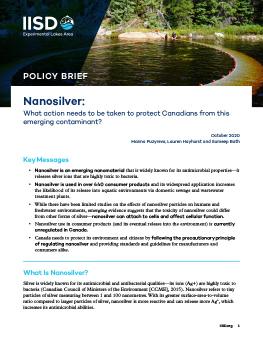
Nanosilver: What action needs to be taken to protect Canadians from this emerging contaminant?
-
Nanosilver is an emerging nanomaterial that is widely known for its antimicrobial properties—it releases silver ions that are highly toxic to bacteria.
-
Nanosilver use in consumer products (and its eventual release into the environment) is currently unregulated in Canada.
-
Canada needs to protect its environment and citizens by following the precautionary principle of regulating nanosilver and providing standards and guidelines for manufacturers and consumers alike.
Nanosilver is an emerging nanomaterial that is widely known for its antimicrobial properties—it releases silver ions that are highly toxic to bacteria.
While it is used in over 440 consumer products, research at IISD Experimental Lakes Area has discovered that nanosilver can have adverse effects on the health of freshwater fish—significant enough to warrant including it as part of Canada’s water safety guidelines for the metal.
In this policy brief, we explore what nanosilver is, why exactly you need to be worried about it, and what Canada should be doing to protect the country's fresh water from this currently unregulated substance.
You might also be interested in
Freshwater connectivity can transport environmental DNA through the landscape
A new study conducted at IISD-ELA found that the movement of water between freshwater bodies can transport eDNA which complicates the question of how accurately it can be used to monitor species.
Northwest Ontario Side Story: IISD Experimental Lakes Area Annual Report 2022-2023
This year's annual report is a celebration of all things creative at the world's freshwater laboratory, from the science to music, photography and theatre.
Microplastics now pervasive in Great Lakes, with 90% of water samples surpassing safe levels for aquatic wildlife: new studies
Data spanning the last ten years reveal that the Great Lakes basin is widely contaminated with microplastics, with potentially dangerous consequences for the wildlife that live within.
These nearly invisible organisms help clean Lake Tahoe's water. Here's how they do it
Plankton are not just a diabolical mastermind on a Nickelodeon show about a sponge who lives under the sea. Lake Tahoe is filled with them—the good kind. Tahoe native zooplankton are making a comeback in the more than 21-mile long lake, helping it look the clearest it has in 40 years. A comeback because until now, the microorganism's population significantly decreased after it's primary predator, the Mysis shrimp, was on the rise, according to previous Sacramento Bee reporting.